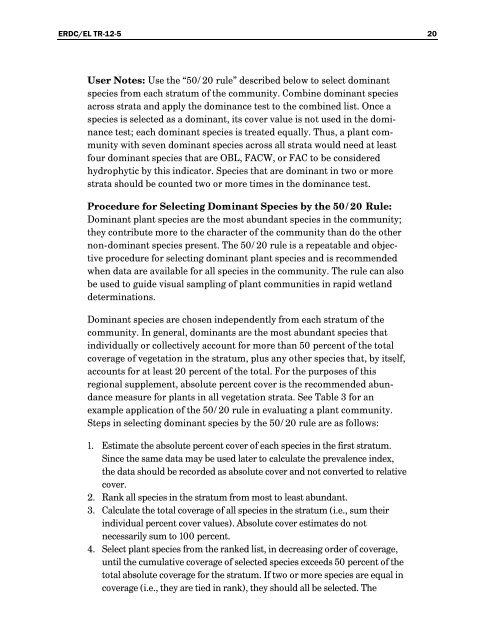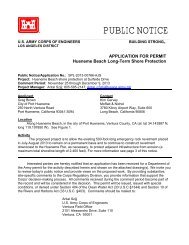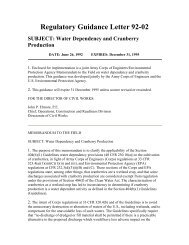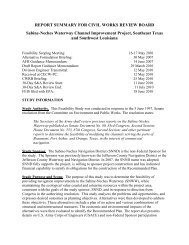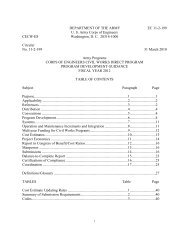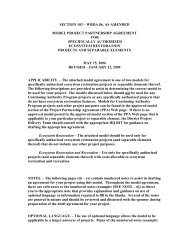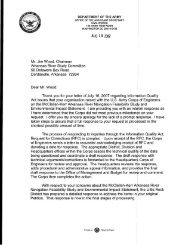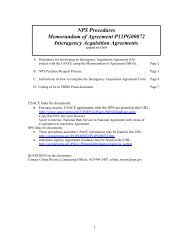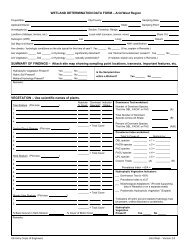Hawaii and the Pacific Islands - U.S. Army Corps of Engineers
Hawaii and the Pacific Islands - U.S. Army Corps of Engineers
Hawaii and the Pacific Islands - U.S. Army Corps of Engineers
Create successful ePaper yourself
Turn your PDF publications into a flip-book with our unique Google optimized e-Paper software.
ERDC/EL TR-12-5 20User Notes: Use <strong>the</strong> “50/20 rule” described below to select dominantspecies from each stratum <strong>of</strong> <strong>the</strong> community. Combine dominant speciesacross strata <strong>and</strong> apply <strong>the</strong> dominance test to <strong>the</strong> combined list. Once aspecies is selected as a dominant, its cover value is not used in <strong>the</strong> dominancetest; each dominant species is treated equally. Thus, a plant communitywith seven dominant species across all strata would need at leastfour dominant species that are OBL, FACW, or FAC to be consideredhydrophytic by this indicator. Species that are dominant in two or morestrata should be counted two or more times in <strong>the</strong> dominance test.Procedure for Selecting Dominant Species by <strong>the</strong> 50/20 Rule:Dominant plant species are <strong>the</strong> most abundant species in <strong>the</strong> community;<strong>the</strong>y contribute more to <strong>the</strong> character <strong>of</strong> <strong>the</strong> community than do <strong>the</strong> o<strong>the</strong>rnon-dominant species present. The 50/20 rule is a repeatable <strong>and</strong> objectiveprocedure for selecting dominant plant species <strong>and</strong> is recommendedwhen data are available for all species in <strong>the</strong> community. The rule can alsobe used to guide visual sampling <strong>of</strong> plant communities in rapid wetl<strong>and</strong>determinations.Dominant species are chosen independently from each stratum <strong>of</strong> <strong>the</strong>community. In general, dominants are <strong>the</strong> most abundant species thatindividually or collectively account for more than 50 percent <strong>of</strong> <strong>the</strong> totalcoverage <strong>of</strong> vegetation in <strong>the</strong> stratum, plus any o<strong>the</strong>r species that, by itself,accounts for at least 20 percent <strong>of</strong> <strong>the</strong> total. For <strong>the</strong> purposes <strong>of</strong> thisregional supplement, absolute percent cover is <strong>the</strong> recommended abundancemeasure for plants in all vegetation strata. See Table 3 for anexample application <strong>of</strong> <strong>the</strong> 50/20 rule in evaluating a plant community.Steps in selecting dominant species by <strong>the</strong> 50/20 rule are as follows:1. Estimate <strong>the</strong> absolute percent cover <strong>of</strong> each species in <strong>the</strong> first stratum.Since <strong>the</strong> same data may be used later to calculate <strong>the</strong> prevalence index,<strong>the</strong> data should be recorded as absolute cover <strong>and</strong> not converted to relativecover.2. Rank all species in <strong>the</strong> stratum from most to least abundant.3. Calculate <strong>the</strong> total coverage <strong>of</strong> all species in <strong>the</strong> stratum (i.e., sum <strong>the</strong>irindividual percent cover values). Absolute cover estimates do notnecessarily sum to 100 percent.4. Select plant species from <strong>the</strong> ranked list, in decreasing order <strong>of</strong> coverage,until <strong>the</strong> cumulative coverage <strong>of</strong> selected species exceeds 50 percent <strong>of</strong> <strong>the</strong>total absolute coverage for <strong>the</strong> stratum. If two or more species are equal incoverage (i.e., <strong>the</strong>y are tied in rank), <strong>the</strong>y should all be selected. The


